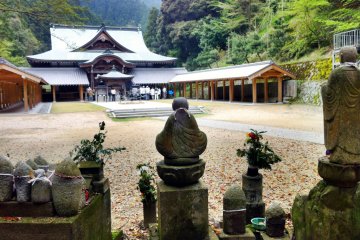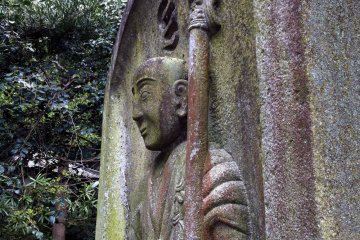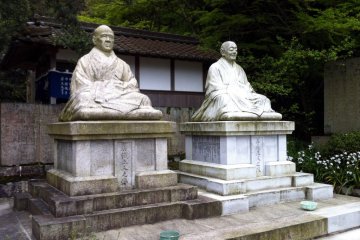Mt. Ishizuchi, or Ishizuchi-san as it’s known in Japanese, dominates the scenery of Saijo. Maegami-ji Temple stands in a valley between the foothills of Ishizuchi in Saijo. The mountain itself is revered as a god or kami, and Maegami-ji means “the temple in front of the god”. Buddhism and Shinto have been closely interrelated over the centuries, and in layout of the grounds and architectural appearance of its main hall, this temple has a lot in common with Shinto shrines. A visit to the nearby Ishizuchi Shrine only confirms this impression. In fact, Maegami-ji used to be the headquarters of the Shinto cult of Mt. Ishizuchi before Ishizuchi Shrine was formed in the Meiji period.
The lions guarding the gateway to Maegami-ji are flanked with cherry trees and the path up through the car park and cemetery is lined with them, creating a riot of pink in early April. The temple precincts are laid out along the valley and the visitor passes through several distinct stages separated by steps. The first stage has a bell tower, some impressive statues of meditating personages, and the Daishi-do. Every temple on Shikoku’s pilgrimage route has a building called the Daishi-do to venerate Kobo Daishi, the founder of the pilgrimage. The one at Maegami-ji is bedecked with lions and birds which could be phoenixes or rocs (or plucked chickens).
From here, a path leads through the trees past various statuary, including a Buddha for aborted babies, and a fiery demon spouting water. Somebody made the discovery that 1-yen coins adhere to this fountain, and consequently, the lower reaches of it are plastered with these rubbishy little coins.
Another stage holds the rather dramatic Main Hall or Hondo, with a torii gate leading to another platform with a shrine. The view down from here on the convoluted roof of the main hall is worth the short climb. The grounds of the temple are home to many varieties of trees and the birds and insects that they attract in each season.
Maegami-ji is one of five pilgrimage temples located relatively close together in Saijo. The others are Yokomine-ji No. 60, Hoju-ji No. 62, Kichijo-ji No. 63, and Koon-ji No. 61. If you visit on a weekend, you’ll encounter large parties of pilgrims arriving by bus.











